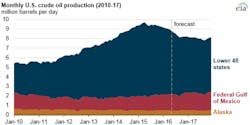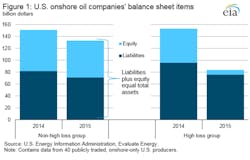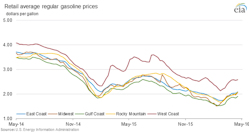Gulf of Mexico increases production as Lower 48 sees decrease
All images courtesy of the U.S. Energy Information Administration
The Lower 48 states are expected to see onshore crude oil production decrease from an average of 7.4 million barrels per day (b/d) in 2015 to 6.46 million b/d in 2016 and 5.76 million b/d in 2017, according to the U.S. Energy Information Administration (EIA). While production in the Gulf of Mexico (GOM) will increase, it will not be enough to offset onshore declines. Total U.S. production is predicted to fall from 9.43 million b/d in 2015 to 8.04 million b/d in 2017.
BakerHughes data show that the number of active onshore drilling rigs in the contiguous 48 states fell 78 percent (from 1,876 to 412) between the weeks ending on Oct. 31, 2014, and April 15, 2016. This decline is expected to contribute to onshore oil production declines of 120,000 b/d through September 2016.
Brent crude oil prices are forecast to average $35 per barrel (b) in 2016 and $41.b in 2017.
An EIA analysis found that the 40 publicly traded onshore-only oil producers in the U.S. had combined losses of $67 billion last year. Sales revenue reductions and write-down assets because of an 18-month decline in crude oil prices are largely to blame.
Eighteen of these companies, called the high loss group (HLG), reported losses in excess of 100 percent of their equity. These companies had more debt and lower margins between production cost and wellhead value, making them more vulnerable to losses.
The 18 HLG companies and 22 non-HLG companies saw similar production rates in 2015, producing 1.2 and 1.4 million b/d, respectively.
The EIA reported the average regular gasoline retail price increase 7 cents from the previous week to $2.14. The price is 35 cents lower than the same time last year. The Midwest, Rocky Mountain, Gulf Coast, East Coast and West Coast regions all experienced price increases.
The average diesel fuel price also increased. It rose four cents to $2.17 per gallon, 62 cents lower than last year. The Gulf Coast, West Coast, East Coast, Rocky Mountain and Midwest regions saw increases.
Natural gas prices mixed across nation
Henry Hub spot prices rose from $1.98/MMBtu to $2.02/MMBtu, the first time it has risen above $2/MMBtu since February. Prices in the Northeast fell from $3.57/MMBtu to $2.28 MMBtu, while Marcellus prices also decreased from $1.47 MMBtu to $1.36 MMBtu. Nymex prices rose $2.036/MMBtu to $2.069/MMBtu.
Total supply fell by 0.6 percent, driven by a 0.5 percent dry production decline. EIA noted that because demand for natural gas in low in April, maintenance is common during this month and affects production. Overall consumption also fell by 12.1 because of mild weather.





